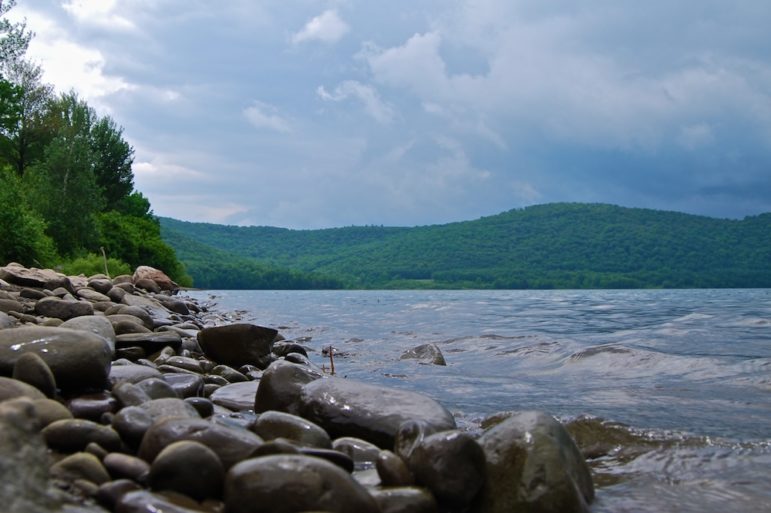
kmitschke
The Cannonsville Reservoir, the city’s third-largest, was at 20 percent capacity on December 1. But other reservoirs in the sprawling city watershed system are much fuller.
While a dry autumn has reservoirs at relatively low levels, the agency in charge of New York City’s billion-gallon-a-day water system says its forecasts show there’s little risk of any protracted problem.
For a number of weeks, newspapers in the city’s west-of-Hudson watersheds have reported concerns about low water levels. Last week, the Delaware River Basin Commission—whose footprint includes the city’s largest watershed—issued a public alert. Friday morning, New York City’s watersheds stood at 57 percent capacity, down from the 81 percent that is normal this time of year.
“The persistently dry conditions through summer and fall resulted in additional drawdown of the reservoirs, but the city is nowhere near a drought watch,” Department of Environmental Protection (DEP) spokesman Adam Bosch tells City Limits. “There are no plans at this point for any type of public notice. In fact, the steady rains of the past few days have helped reverse the trend. Yesterday alone we saw more than 6 billion gallons of runoff into the city’s reservoirs. We expect that trend to continue.”
The city’s drinking water system—a marvel of natural bounty, shrewd engineering and prescient planning—consists of three watersheds spanning eight counties connected to the city via hundreds of miles of tunnels, streams and pipes. The older and smaller Croton watershed lies east of the Hudson River. The Catskills and Delaware watersheds, which are bigger and provide higher quality water, lie to the west of the Hudson. (See a map with updated reservoir levels here.)
The upstate newspaper Daily Freeman reported back in October that the city of Kingston had issued a “drought alert” because of low levels in its local reservoir system, adding that officials with DEP were aware of the low levels in their own nearby waterbodies but not planning any alert.
Last week, however, after reservoir levels in the Delaware River Basin dropped below 40 percent overnight, the River Basin Commission—an intergovernmental body that regulates water uses along the river—issued a drought watch. One of the Delaware watershed reservoirs, the Cannonsville, had dropped to 18 percent of capacity.
According to the Times Herald Record, the city responded by reducing its use of water from that basin from 800 million gallons to 680 million gallons a day, increasing its use of Croton water to make up the difference.
The Commission itself planned to release more fresh water down the Delaware River to repel the salt water that has crept 19 miles upriver from the river’s typical tide line—about halfway to the point where it would compromise the intake pipes for Philadelphia’s water supply, the paper said.
The state’s Department of Environmental Conservation issued a drought watch—the first level on its four-step drought alert scale that ends, literally, with “disaster”—for the entire state in July. That was later upgraded to the second level, “warning.” On November 3, DEC scaled the alert back to a watch, but DEC’s website still cautions: “Portions of New York State have a long term precipitation deficit of up to 16″ since November 1, 2015. A sustained period of near-normal precipitation will be necessary to return to normal levels of water availability.”
The city DEP believes that conditions could improve dramatically in the next few months. “Our meteorologists are seeing some very strong signals in the long-term climate forecasts that indicate a potential return of the polar vortex in late January. This means we’ll likely get a deep snowpack in the mountains, which will also continue to refill the system in the spring,” Bosch says. “In short, we’re in good shape at this point – and storage is on its way up.”
Were DEP to issue some public advisory using its published water alert protocol, the first step would be a “watch,” which is supposed to be declared when either the Catskills or Delaware system shows less than a 50 percent probability of filling up by June 1, the start of DEP’s water year. A “warning” or “emergency” would be declared if the situation worsens. Each alert level triggers public notification procedures and use restrictions.
The alert system was most recently triggered in 2001-2003, when a watch was upgraded to a warning and ultimately to a stage I emergency kept in place from April into November 2002.
Simultaneously 150 miles away and as close as the nearest tap, the city’s massive and reliable water supply is an often overlooked asset. As City Limits and WNYC reported in our 2015 Cost of Water series, the system does face challenges related to repair projects, climate change and cost.








